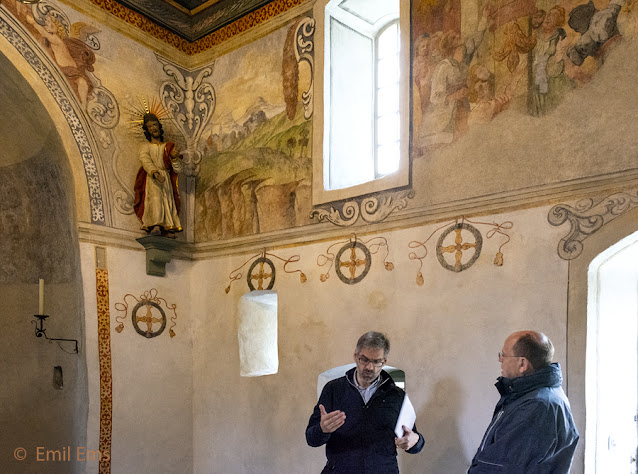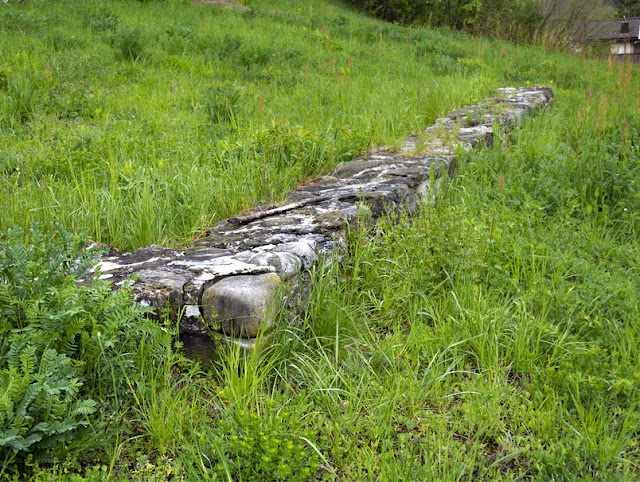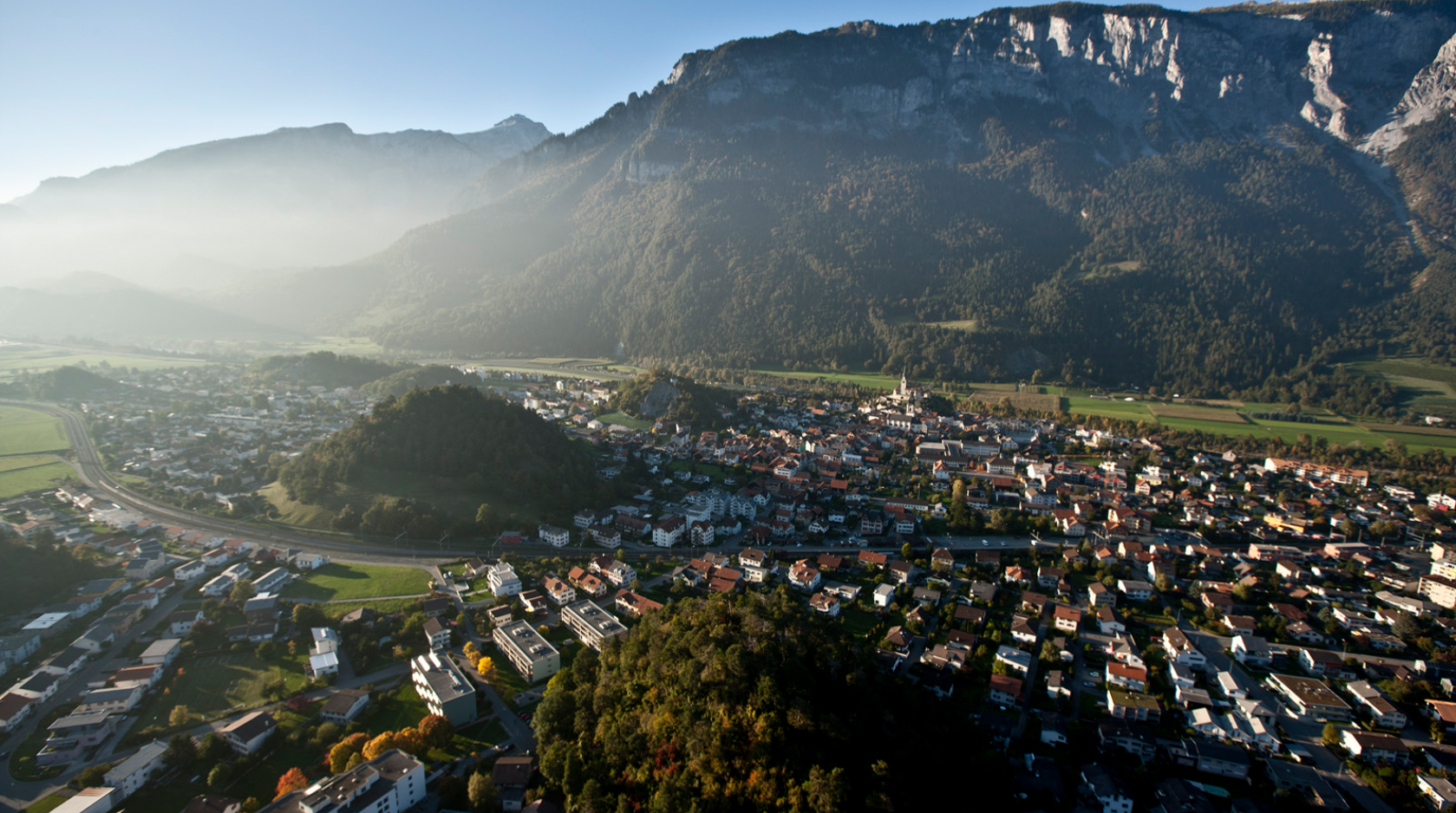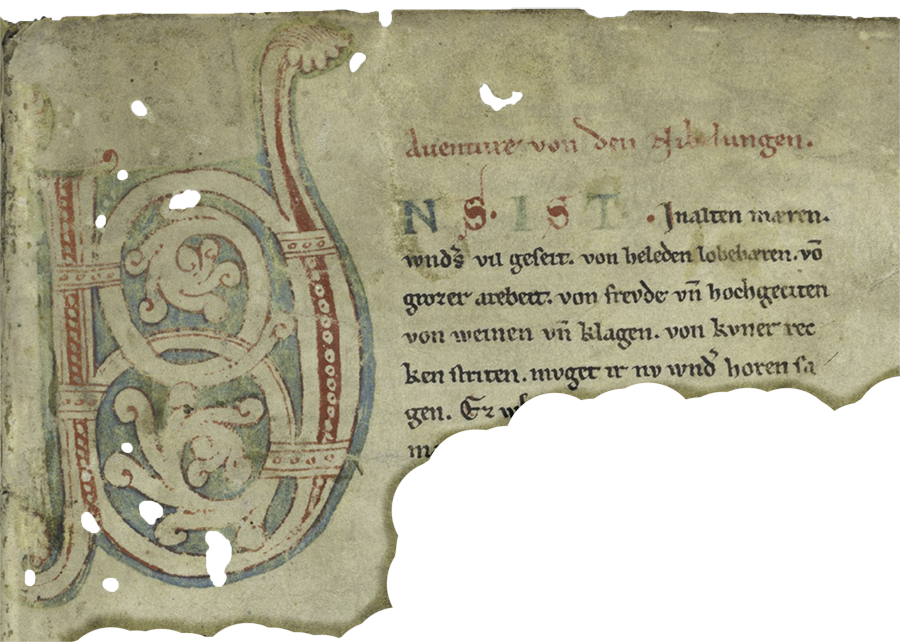WHERE IT ALL BEGAN
 |
| Interior of Chaplutta Sogn Pieder |
 |
| Source: Yale University Library |
... Woosh! With a great sucking sound, the time machine breaks and slings us back to present time. Suddenly, it is again the morning of 29 April 2019 and us three brothers have just travelled the Alpine Rhine upstream to a town in Graubünden (Grisons) called Domat/Ems. Our aim is to search for the ultimate source of our family name. We have arranged to meet a guide at the local train station at 10 am, but are a bit early. My brothers are drinking coffee in the railroad café whilst I stay outside to watch the 10 o'clock train arrive.
As I am pacing the station, suddenly, I see a lonely figure standing a bit in the distance. It turns out to be our guide, who actually lives in town, he is the school master, and has just chosen the station as a convenient meeting place.
 |
| A lonely guide awaiting his customers |
Soon, we have a meeting of the minds, approach each other, and I rush off to fetch my brothers. Here they are standing with the guide in front of the station. The guide's swarthy complexion betrays his indigeneity. He is a true Raeto-Roman and people in the region may have looked like him already over 2000 years ago, when Raetia was incorporated into the Roman Empire. He even has Romansch as his mother-tongue, no less than a language derived from vulgar Latin spoken in the territory during the last two millenia!
 |
| Our guide has found us and we are ready to start our tour |
As he explains it to us, the prefix "Domat" is the Romansch version of the town's name. It means "river fork", derived from the Latin term "tum duo" (then two). "Ems" is the version used by the German speaking inhabitants, who nowadays are in majority. But, as we will find out presently, also "Ems" has ancient roots.
Without further ado, we are on our way towards a sizeable knoll in the distance, which the guide calls "Tuma Casti" (Castle Hill). In fact, there are fully twelve such tuma in the town, raising up like warts from the alluvial plane. The guide assures us that the ascension will be easy, so we approach the hillock with confidence. After some effort, we are glad to arrive at a small chapel on its Southeastern slope, which we approach with reverence, since it is more than one thousand and two hundred years old! We are now back to the Chaplutta Sogn Pieder (St Peter's Chapel) that we have already admired in our time voyage (see title picture). Granted, it is small, but it still looks impressive to us, given its venerable age and simple elegance.
 |
| Chaplutta Sogn Pieder. Was standing here already in 800 AD |
It turns out that this is one of the oldest sacral buildings still standing on the Upper Alpine Rhine. But, excavations have shown settlements here from as far back as the Bronze Age (from about 1100 BC). In other words, this is where people settled down first on the heights above the alluvial plane just downstream of the river fork that divided the Rhine into two branches, the Vorder- and Hinterrhein (Anterior and Posterior Rhine). If that wasn't enough, there exists also a document from 765, one of the oldest in Switzerland, and certainly the oldest in the Alpine Rhine region, that mentions a piece of property located where the chapel is now standing.
Our guide is proud to show us an excerpt from this ancient document. Its author is Bishop Tello from Chur, the last of the famous Victorine Bishops/Praeses (Governors) of Raetia Curensis (see A river runs through it). The script constitutes a donation, to the Monastery of Disentis, of a great number of properties around Chur, the donation becoming active only after Vitto's death. Some of the properties mentioned provide also for a lien to employees working there, or already holding a lien fyoffed by the Bishop, so as to maintain their sustenance.
This document is so old, that the original is already lost. But there exist copies, copies of copies, and copies of copies of copies ... One would have thought that Disentis had taken great care to preserve the original, since it is the main beneficiary. Indeed, they would still have it as a treasure in their library, if only the monastery had survived the onslaught of the Saracens in 940 AD. Unfortunately, it all burned down and all documents with it. But let's take a closer look at the "parchment" our guide is showing us.
 |
| Excerpt from Bishop Vitto's donation. Copy of document from Anno 765 |
You will of course not have any problem with reading and understanding this text. But, just in case you are unfamiliar with its old and unwieldy writing style, allow me to present to you my own humble interpretation. If your superior wisdom would urge you to better me, I would be pleased to se this in a comment to the blog.
"Likewise, this Maiorinus may keep, as lien under the Monastery [of Disentis] for his use and the sustenance of his wife and sons, the farm that he holds in Amedes. Should the same [Maiorinus] choose to forego this lien, this property shall forever remain with the Monastery [of Disentis] and shall never be partitioned off by anyone."
So there, the first time the name of Ems (in its Raeto-Roman version of Amedes) appears in writing! At least in the Alpine Rhine Region. We bow in reverence before this unique message from the past.
Still, time moves on and we have to leave this haloed place. But, on its outside, just a bit down to the left, resides another intriguing remnant of the ages. We discuss what kind of building this foundation could have supported in ancient times. The guide believes it to have been a military barracks from post-Roman times. I personally tend to believe this rather to be the remnants of a refectory adjacent to and built concurrently with the chapel. After all, this piece of land had been donated to the Monastery of Disentis and must thereupon have been used as an Abbatis Cella (a dependancy), with the small chapel built there, as well as utility buildings to complement it.
 |
| The foundation of an ancient refectorium? |
We go on to discuss the root of the word "Amedes". According to the guide, it is commonly believed in the valley that this could be an old pre-Roman term with the same meaning as "Domat". Unfortunately, he could not point us to any etymologic studies underpinning this belief. In other words, it is up to our imagination to put forward alternative hypotheses for this name's origin.
But the weather is not inviting for such deep reasonings. As it is drizzling and quite cold outside, we thank our guide and move on to a well deserved, albeit unnotable lunch, and thereafter make haste to go on with our voyage, upriver along the Posterior Rhine.
Sitting in our voluminous Porsche's backseat, I let my mind roam and venture into speculations about the issue at hand. The guide's interpretation of "Amedes" does not appear plausible. Even the view, that the term "Domat" would derive from Latin "Tum duo" may be an after-construction, since I have not been able to find any entymologic documentation for this term either. It serves to keep a critical distance to such conclusions, unless they be underpinned by concrete proof.
Maybe, a closer view at the type of settlement that evolved in early Medieval times at the site of present day Domat/Ems could provide a clue. The site lies not only downstream of the confluence of Rhine's two branches, but also on the crossing of two routes leading South across the Alps: the first, more important, rambles along the Posterior Rhine up to the Splügen and San Bernardino Passes; the second climbs along the Anterior Rhine and thereafter to up to the Diesrut and Greina Passes (the Lukmanier Pass was developed first after the founding of Disentis). However, none of these routes could be traficked by carriages, this was possible only by taking the direct route South from Cur to the Septimer Pass. Mule trains would be the main conduit of travel, if travelling through Amedes.
Travellers, with their mule trains, who laboured their way North along the perilous Anterior Rhine, had to pass difficult passages, such as the notorious Via Mala. For them, arriving at the comparatively open plane at the confluence of the two Rhines must have been welcome. It makes sense that some kind of staging station had been located there, possibly already in Roman times, but certainly in the Raeto-Roman successor province. Even a small military outpost could have been stationed at this place. Such establishments would of cause have been accompanied by a "curtis", that is, an agricultural estate to provide sustenance, as well as grazing ground for the mules arriving from the passes. It would not have been a large estate, since there was not much ground for cultivation on the Southern side of the Rhine, and the valley certainly was flooded regularly and consisted of marches and swamps.
Seen in this way, the Tuma Casti appears as a suitable site for such a station, possibly located flush along the road, which would typically run on elevated ground above the river and pass by this small hill. Of course, already in antique times, a station would have been adorned by a small place of worship, to thank the Gods for passage or placate them with sacrifices before attempting the Passes. So, it makes sense that a small chapel later rose on this site, to be replaced eventually by the more sizeable church we still can admire nowadays.
But what about the name of "Amedes"? Besides the guide's interpretation, which would make sense if found to be proven through etymologic analysis, there is also the possibility that such a station would have been named after one of its owners. Probably not the founder, since the station could have existed for centuries. But why not an owner who was respected for building, for instance, a small edifice for travellers to worship in? It need not have been a chapel. A cross with a roof over it, or a "Marterl", memorising some miraculous rescue of a travelling party, could well suffice.
 |
| A bird's view of present day Domat/Ems. Tuma Casti in the background to the left of the church. Photographer: Andrea Badnett |
So there, my own hypothesis for the origin of our name! Lest you think me over-confident, be assured that the last word is not yetpoken on this topic. We will have to deliberate it for years to come, unless some evidence surfaces that settles the issue once and for all. I sincerely hope so, our family name depends on it!
Exhausted by my intellectual musings, I fall asleep whilst brother Ludwig, at the wheel, drives us towards the high rises in good speed. Notably, we take the same route as the mule teams were trodding so many centuries ago, although we are boring through the mountain bases rather than labouring up to the passes. Deeply entrenched in sleep, I wake up first when the sun is tickling my nose, and we are already in Ticino, rushing South towards Lombardy, the land "wo die Zitronen blüh'n".
Exhausted by my intellectual musings, I fall asleep whilst brother Ludwig, at the wheel, drives us towards the high rises in good speed. Notably, we take the same route as the mule teams were trodding so many centuries ago, although we are boring through the mountain bases rather than labouring up to the passes. Deeply entrenched in sleep, I wake up first when the sun is tickling my nose, and we are already in Ticino, rushing South towards Lombardy, the land "wo die Zitronen blüh'n".





Comments
I very much enjoy reading about your search for your roots.
Many thanks!
You have not mentioned whether you will also learn Rhaeto-Romanic because of your Swiss genealogy?
Heinz
Det var en bra berättelse.
Per